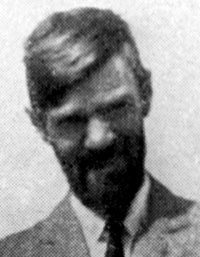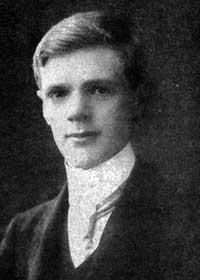

D H Lawrence in the mid-1920s.
The controversial writer and artist, David Herbert Lawrence, was born on 11th September 1885 in the small mining town of Eastwood in west Nottinghamshire. He was the fourth child of Arthur and Lydia Lawrence. Arthur was a ‘butty’, a type of mining contractor, and Lydia considered herself ‘a superior soul’, being better educated than her husband and committed to self-improvement for her and her children.
From the age of seven he attended Beauvale Board School and although he found school ‘an uncomfortable experience’ he managed to win a County Scholarship to Nottingham High School and started there in 1898. He did reasonably well in modern languages and mathematics but his performance tailed off. In addition, the expense of clothes, books and railway tickets put a strain in the household budget and, early in 1901, he left school and started work as a clerk at Haywards, manufacturers of surgical appliances, on Castle Gate in Nottingham.
The summer of 1901 saw Lawrence accompanying his mother on a visit to the Chambers family at Haggs Farm, a few miles north of Eastwood. Over the next seven years the farm became his second home and the Chambers became an alternative family: indeed, ‘all his life he remembered it as a place of almost paradisal delight.’ Although they were relatively poor, the family was lively, argumentative and interested in literature and the arts. Jessie, the youngest daughter, became his ‘intellectual companion’ and they spent many hours reading and discussing books. She encouraged him to write and played a crucial role in his development as a writer.
However, the year was dominated by family tragedy when his older brother and his mother’s favourite, Ernest, contracted a skin infection that proved fatal. Lydia was devastated by his death but her grief was interrupted when Lawrence became seriously ill with pneumonia and was bed-ridden for weeks. She ‘was roused from her despair and nursed him heroically’ until he recovered. The illness marked the end of his childhood and from then on the relationship between Lawrence and his mother became central to their lives.

Lawrence in 1906
Once he had recovered from his illness Lawrence embarked on a career in teaching, starting as a pupil teacher at the British School in Eastwood in October 1902 and then attending the Pupil-Teacher Centre in nearby Ilkeston between 1904 and 1906. Intellectually, he now began to move in new worlds and his social circle grew at this time to include fellow pupil-teachers from Eastwood, Louisa (‘Louie’) Burrows from Cossall and Willie Hopkin, a progressive local councillor and magistrate, columnist and socialist.
In October 1906 he entered University College, Nottingham to study for a Teacher’s Certificate. Although quickly disillusioned with the standard of teaching it did at least give him time to read and write. The following year he started work on what was to become his first novel, The White Peacock, wrote poems and published a short story, The Prelude, in the Nottinghamshire Guardian.
He qualified in June 1908 and in October took up a teaching post at the Davidson School in Croydon. The following summer Jessie sent some of his poems to The English Review. Its editor, Ford Madox Hueffer, published some of them but suggested he produced some stories based on his mining background. This was the breakthrough Lawrence needed and he went on to write Odour of Chrysanthemums and his first play, A Collier's Friday Night; his second play, The Widowing of Mrs. Holroyd, followed in 1910.
While he was working in Croydon, Lydia was diagnosed with cancer. Lawrence came up to Eastwood every other weekend and nursed her until her death in December 1910. During his mother’s illness he became close to Louisa Burrows and proposed to her but broke the engagement off the following year claiming poverty and ill health. This period also saw his involvement with Alice Dax, the unconventional and ‘progressive’ wife of an Eastwood chemist, falling in love with Helen Corke (a schoolteacher friend in Croydon) and a brief and unhappy sexual relationship with Jessie Chambers.
He remained in Croydon until another severe bout of pneumonia in November 1911 forced him to abandon school teaching. In March 1912, while staying with his sister Emily in Eastwood and looking for advice on future career options, he took up an invitation to lunch at the house of Ernest Weekly, a professor of modern languages at Nottingham University College. At the house he met Weekly’s German-born wife, Frieda and there was an immediate rapport between them. This was a turning-point in his life and not only was he determined to be with Frieda but he also decided to become a professional writer. They began to see each other regularly and within two months they had eloped to Germany, not returning until the summer of 1914; they married in Kensington Registry Office on 14 July of that year. While travelling in Germany and Italy Lawrence managed to finish his novel, Paul Morel, which after further revision became Sons and Lovers (published in May 1913), and produced some short stories.
In September 1915 Methuen published The Rainbow but the book was banned at Bow Street Magistrates Court in November of that year and Lawrence’s career as a writer was badly damaged. They left London to stay in Cornwall for a while until they could leave England. While living at Zennor Lawrence finished writing Women in Love (in October 1916) and starting work on a series of essays on American literature. In October 1917 they were served with a military exclusion order under the Defence of the Realm Act and expelled from Cornwall on the grounds that it was dangerous to have an enemy alien living close to the coast.
From May 1918 Frieda and Lawrence lived at Mountain Cottage, near Wirksworth in Derbyshire, paid for by his sister Ada but in November 1919 they embarked on a long period of travel in Europe, Ceylon, Australia, Mexico and New Mexico. He returned to England only three times: in 1923, 1925 and 1926.
Poor health forced Lawrence to return to Europe in 1925 and much of the next five years was spent in Italy. He died on 2nd March 1930 at Vence in the south of France.
Professor John Worthen has written a more comprehensive online biography of Lawrence which is available on the Nottingham University website.